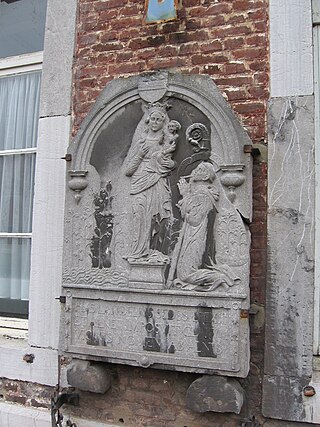Related Research Articles

Saint Waltrude is the patron saint of Mons, Belgium, where she is known in French as Sainte Waudru, and of Herentals, Belgium, where she is known in Dutch as Sint-Waldetrudis or -Waltrudis. Both cities boast a large medieval church that bears her name.

Lobbes Abbey was a Benedictine monastery in the municipality of Lobbes, Hainaut, Belgium. The abbey played an important role in the religious, political and religious life of the Prince-Bishopric of Liège, especially around the year 1000. The abbey's founding saint is Saint Landelin; four other saints are also connected with the abbey.

Saint Landelin is a saint in the Eastern Orthodox Church and Roman Catholic Church.

The Ducasse de Mons, also commonly known as the Doudou, is a traditional folk festival held in Mons, Hainaut, Belgium, on Trinity Sunday. The feast comprises two important parts: the procession, including the descent and the uprising of the Saint Waltrude's shrine, as well as the combat named Lumeçon between Saint George and a dragon. Since 2008, it is recognised as a Masterpiece of the Oral and Intangible Heritage of Humanity by UNESCO.

Alice of Namur was the daughter of Count Godfrey I of Namur and Countess Ermesinde of Luxembourg.

Crespin Abbey was a Benedictine monastery in the commune of Crespin in the department of Nord, France, founded around 648 by the reformed brigand Landelin of Crespin, also the first abbot, and dissolved in 1802.

Saint Waltrude Collegiate Church is a Roman Catholic parish church in Mons, Belgium, named in honour of Saint Waltrude. The church is a notable example of Gothic architecture, and is protected by the heritage register of Wallonia.

Aye is a Belgian Catholic saint. She has been referred to also as Aia, Aya, Agia, and St. Austregildis.
Brunulphe III or Brunulphe III of the Ardennes , was a Frankish nobleman and Merovingian Count of the Ardennes. He was assassinated by King Dagobert I in the Middle Ages.
Alberic of the Ardennes, Alberick, or Albéric l'Orphelin de Hainaut d'Ardenne, also called the Orphan, was a Frankish nobleman and Merovingian Count of Hainaut.
Brunulphe or Brunulphe of the Ardennes was a Frankish nobleman and Merovingian Count of the Ardennes.
Saint Bertille of Thuringia(French: Sainte Bertille de Thuringe or also known as Saint Bertilla, the daughter of Bercarius, King of Thuringia, was a Merovingian princess and Frankish saint who resided in the County of Hainaut in Belgium. Bertille was the mother of Saint Waltrude and Saint Aldegund, foundress of Maubeuge Abbey.
Saint Walbert IV(French: Sainte Walbert IV), also known as Vaubert, Waubert, or Waudbert was a Merovingian Count of Hainaut and a Frankish saint. He was the father of Saint Waltrude, and Saint Aldegund, first abbess of Maubeuge.
Walbert I, Vaubert, Waudbert, or Vautier also known as Walbert of the Ardennes was a Frankish nobleman and a Merovingian Count of Hainaut.
Walbert II also called the Younger, was a patrician, Roman senator, and Merovingian Count of Haynau and of the Ardennes.
Walbert III was a Frankish nobleman and a Merovingian Count.

Landry, Landric, Landericus, or Landry of Soignies, commonly known as Saint Landry of Metz was a Roman Catholic Bishop of Metz, Benedictine abbot of Haumont and Soignies, and a Frankish saint. He was the son of Saint Waltrude and Madelgaire.

Dentelin, Dentelinus, or Saint Dentelin of Soignies was a Frankish saint. He was the son of Saint Waltrude and Madelgaire.

Aubert of Cambrai or Aubertus was a Merovingian Bishop of Cambrai and Arras and a Frankish saint.

Hautmont Abbey or the Abbey of Hautmont, was a Benedictine monastery in Hautmont in the department of Nord, France.
References
- ↑ Baring-Gould, S. (1898). The Lives of the Saints. United Kingdom: J. C. Nimmo.
- ↑ Documents pour faire suite à l'histoire de Sainte Waudru, patronne de Mons. (1846). (n.p.): (n.p.).
- ↑ CORET, J. (1674). Le Triomphe des vertus euangeliques representé dans les actions heroïques de S. Aye Comtesse de Haynau, Duchesse de Loraine, etc. L.P.. (n.p.): La Veuve Simeon de la Roche.
- ↑ Biographie nationale. (1866). Belgium: H. Thiry-Van Buggenhoudt.
- 1 2 3 4 5 6 Vos, J. (1865). Lobbes, son abbaye et son chapitre, ou: Histoire complète du monastère de Saint Pierre à Lobbes et du chapitre de Saint Ursmer à Lobbes et à Binche. France: Peeters.
- ↑ Devillers, L. (1857). Mémoire historique et descriptif sur l'église de Sainte-Waudru à Mons. (n.p.): Masquillier.
- ↑ Gambier, A. (1789). Essai historique sur la rentrée des biens tant à l'église qu'à la nation, avec des réflexions sur la nature de ces biens. (n.p.): (n.p.).
- 1 2 Baring-Gould, S. (1898). The Lives of the Saints. United Kingdom: J. C. Nimmo.